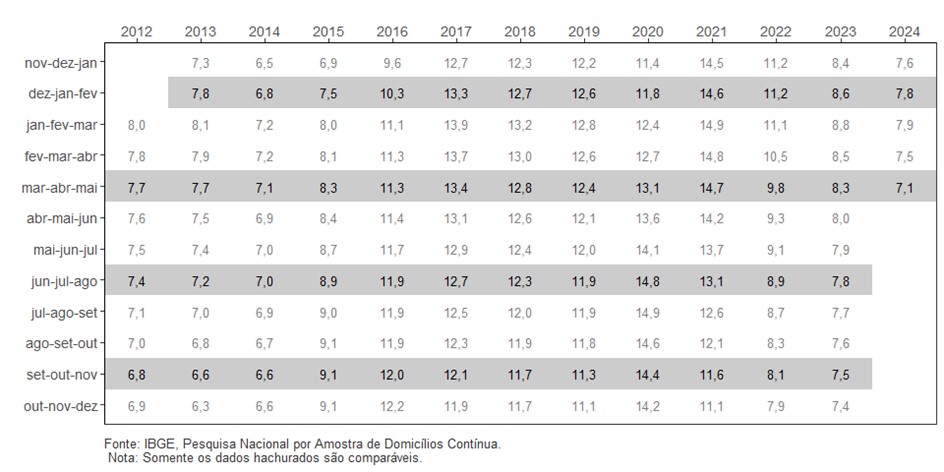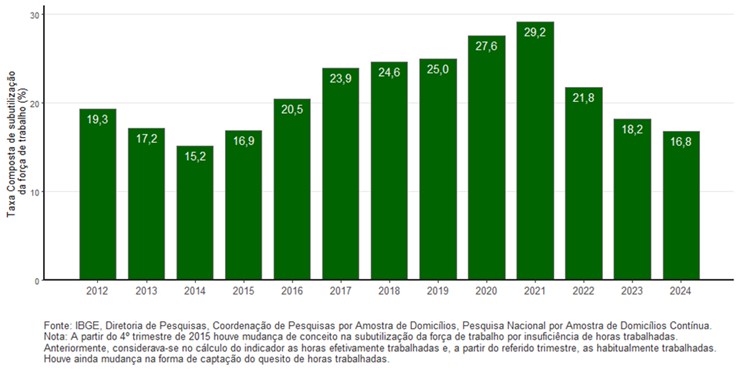Continuous PNAD: unemployment rate is 7.1%; underutilization rate is 16.8% in quarter ending in May
June 28, 2024 09h00 AM | Last Updated: July 01, 2024 02h03 PM
The unemployment rate (7.1%) in the quarter ended in May 2024 retreated 0.7 percentage points (p.p.) against the quarter from December to February 2024 (787%) and fell 1.2 p.p. over the same moving quarter in 2023 (8.3%). This was the lowest unemployment rate for a quarter ended in May since 2014 (7.1%).
| Indicator/Period | Mar-Apr-May 2024 | Dec-Jan-Feb 2024 | Mar-Apr-May 2023 |
|---|---|---|---|
| Unemployment rate | 7.1% | 7.8% | 8.3% |
| Underutilization rate | 16.8% | 17.8% | 18.2% |
| Real usual earnings | R$3,181 | R$3,150 | R$3,013 |
| Change of usual real earnings in relation to: | Stable (1.0%) | 5.6% | |
The unemployed population (7.8 million) retreated in both comparisons: -8.8% (less 751 thousand persons) in the quarter and -13.0% (less 1.2 million persons) in the year. It was the largest contngent of unemployed persons sice the quarter ended in February 2015.
The employed population (101.3 million) was a record in the time series started in 2012, growing in both comparisons: 1.1% (more 1.1 million persons) in the quarter and 3.0% (more 2.9 million persons) in the year. The employment- population ratio - percentage of employed persons in the population at working age - was 57.6%, growing in both comparions: 0.5 p.p. against the previous moving quarter (57.1%) and 1.2 p.p. in the year (56.4%).
The composite underutilization rate (16.8%) retreated in both comparisons> -1.0 p.p. in the quarter and -1.3 p.p. in the year. It was the lowest underutilization rate for a quarter ended in May since 2014. The underutilized population (19.4 million persons) was the smallest one since the moving quarter ended in January 2016 (19.1 million), retreating in both comparions: -5.9% (less 1.2 million) in the quarter and -6.2% (less 1.3 million) in the year.
The time-related unemployed population (5.2 million) remained stable in both comparions, as well as the population out of the workforce.
The discouraged population (3.3 million) reached its smallest contingent since the quarter ended in June 2016 (3.2 million) and retreated in both comparisons: -9.4% (less 344 thousand persons) in the quarter and -10.7% (less 399 thousand persons) in the year. The percentage of discouraged persons in the working force or discouraged (3.0%0 also retreated in both comparisons: -0.3 p.p. in the month and -0.4 p.p. in the year.
The number of persons employed in the private sector with a formal contract (excluding domestic workers) reached 38.326 million, a new record in the time series of the Continuous PNAD, started in 2012. It rose 0.9% (more 330 thousand persons) in the quarter and 4.1% (more 1.5 million persons) in the year. The number of persons employed in the private sector without a formal contract (13.7 million) was also a new record in the time series, with rises of 2.9% *more 383 thousand persons) in the quarter and of 5.7% (more 741 thousand persons) in the year.
The number of self-employed workers (25.5 million persons) remained stable in both comparisons, as well as the numbero f employers (4.2 million persons) and the number of domestic workers (5.8 million persons).
The number of persons employed in the public sector (12.5 million) grew in both comparions: 4.3% (more 517 thousand persons) in the quarter and 3.9% (more 469 thousand persons) in the year.
The informality rate was 38.6% of the employed population (or 39.1 million informal workers) against 38.7% in the previous moving quarter and 38.9% in the same moving quarter of 2023.
Usual real earnings from all jobs (R$3,181) did not change significantly in the quarter and grew 5.6% in the year. The usual real wage bill (R$317.9 billion) hit a new record, growing in both comparions: 2.2% (more R$6.8 billion) in the quarterly comparions and 9.0% (more R$26.1 billion) in the year.
Unemployment rate - Brazil -2012/2024

The workforce (employed and unemployed persons) was estimated at 109.1 million persons in the quarter between March and May 2024. That population grew in both comparions: 0.3% (more 330 thousand persons) over the quarter eneded in February 2024 and 1.6% (more 1.8 million persons) over the same moving quarter last year.
According to the activity groups, the analysis of the contingent of employed persons of the moving quarter from March to May 2024 in relation to the quarter from December 2023 to February 2024 showed an increase in the group of Public administration, defense, social security, education, human health and social services (4.4% or more 776 thousand persons) and a reduction in the group of Transportation, storage and mailing (2.5% or less 146 thousand persons). The other groups did not change significantly.
The comparions with the same moving quarter in 2023 showed increases in: Construction 3.8% or more 273 thousand persons), Transportation, storage and mailing (6.3% or more 338 thousand persons), Information, communication and financial, real estate, professional and administrative activities (6.7% or more 813 thousand persons), Public administration, defense, social security, education, human health and social services (4.7% or more 827 thousand persons) and Other services (4.6% or more 242 thousand persons). The group of Agriculture, livestock, forestry, fishery and acquaculture (3.2% or less 262 thousand persons) reduced. The other groups did not change significantly.
Composite underutilization rate - Quarter from March to May - Brazil - 2012 to 2024 (%)

According to the activity groups, the analysis of the real monthly average earnings usually received in the main job showed stability in all the groups over the quarter from December 2023 to February 2024.
The comparison with the quarter from March to May 2023 showed an increase in the categories: Industry (7.8% or more R$222), Trade, repair of motor vehicles and motorcycles (5.4% or more R$136), Transportation, storage and mailing (5.5% or more R$155), Public administration, defense, social security, education, human health and social services (5.8% or more R$245) and Other services (9.8% or more R$225). The other groups did not change significantly.
According to the employment type, the analysis of the real monthly average earnings usually received in the main job remained stable in all types against the quarter from December 2023 to February 2024.
The comparions with the quarter between March and May 2023 registered increases in: Employees with a formal contract (4.1% or more R$116), Employees without a formal contract (5.7% or more R$116), Employees in the public sector (including statutory officials and the military) (6.4% or more R$291) and Self-employed workers (7.3% or more R$176).

